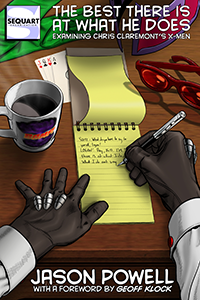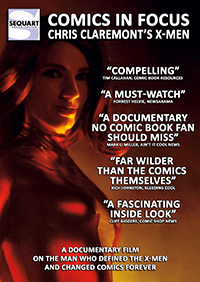Damon Lindelof is an unabashed nerd in Hollywood. Lindelof’s purported first conversation with JJ Abrams was mainly a discussion about Star Wars[i]. His enjoyment of comics lead him to recruit Paul Dini, Jeph Loeb and Brian K. Vaughn as writers on Lost. The storytelling of comics was translated into the series of Lost with the structure of a single-powerful narrative per episode and an overarching-plot that would hook viewers into the series. Lindelof was eventually persuaded to write a comic for Marvel, and was teamed-up with Lenil Francis Yu. The miniseries was entitled Ultimate Wolverine vs Hulk and was within the cannon of the Ultimate Marvel Universe. Unfortunately the series is mostly remembered for its 3-year gap between the second and third issue. Lindelof struggled with balancing the demands of writing for Lost and writing for the miniseries, that sadly the series was shelved for two-years before reaching its completion in 2009. That being said, the series is one of the most enjoyable comics written in the ‘00s and demonstrates that Lindelof’s talent transcended television.
The series begins with a magnificent hook for readers. Wolverine awakens delirious in Tibet and see’s that his legs have been torn off by the Hulk. Given the massive expansion of comics it is natural that few images in a comic make a lasting impact on individual consciousness. More often than not, covers seem to be the only aspect of comics that are cited as an “iconic” images in comic history. But, Lenil Francis Yu’s stunning double-paged spread may be the most iconic image of comics in the ‘00s. The image serves as not only the greatest hook for the series, but also is an image that forever remains ingrained in association with both the series and the iconic characters. The image attracts so much mystery and intense fan reaction both for and against. No major splash has made such a succinct and powerful impact both on the actual story being told but on the collective consciousness of readers in general.
Damon Lindelof’s hook for issue one demonstrates the liberal freedom that comes with writing in the Ultimate Universe. The image of the Hulk ripping Wolverine in half shows that Wolverine is not indestructible as commonly shown in the mainstream Marvel Universe. The image offers a clear and fascinating distinction between mainstream Marvel. The Ultimate Wolverine is in far greater danger when confronting the Hulk as his adamantium skeleton does not protect him from the Hulk’s raw power.
The image also provides comedic-logic to the realism purportedly strived for in the Ultimate Universe. Many of the characters in the Ultimate Marvel Universe were given more practical costumes to wear, with The Ultimates resembling a black ops group rather than superheroes. But even more than the cosmetic facelift, the Ultimate Marvel Universe depicted superpowers as much more finite. Eventually Johnny Storm would stop being the Human Torch after burning all the fat necessary to support his mutation. Giant Man could only reach 59 ft. tall before breaking the square cube law. Only Magneto came out much more powerful than he was in the mainstream Marvel Universe. For Wolverine, the more logical argument would be that the bonding of his adamantium skeleton did not coat his joints. It is mentioned in passing during the extended-flashback that Wolverine was not likely to have an adamantium lacing on his joints as that would prevent basic movement. Wolverine is not immune from danger, he can be injured and will not instantly recover. Conversely, the bemusing irony is that Wolverine’s actual power of healing prevents him from dying from such a severe injury. As such, Lindelof has his debut issue loaded with a dark satiric wit that does not subside as the series continues. Logan’s feral senses smell his own legs, and he slowly crawls up a mountain to regain them. It’s incredibly grand and fitting for superhero comics while at the same time ludicrous in its logic.
After the iconic hook for the first chapter there is an extended flashback that deals with what lead Wolverine to confront the Hulk. In the mainstream Marvel Universe Wolverine was introduced in The Incredible Hulk as a Canadian Captain America. The character was essentially a one-off character, but Len Wein re-utilized the character in his run on X-Men. The character was always envisioned as the dark member of the ensemble, a loose-cannon that could serve as a foil to gentler characters. But as the years progressed Wolverine’s popularity grew, and so too did his involvement in the scope of the Marvel Universe. Eventually Wolverine would become softer as he transformed from a loose cannon to a ronin. But Mark Millar eradicated Wolverine’s nobility in his run on Ultimate X-Men, instead making him be a sadistic nihilist who only slowly gains a measure of humanity as the stories progress. Lindelof takes this ambivalent characterization of Wolverine to heart in his introductory chapter in the miniseries.
Logan is offered the chance to secretly assassinate the Hulk and he immediately accepts. Even Nick Fury is surprised by how easy it is for Logan to agree to kill someone. No major insight is offered to Logan, he simply replies that he is thrilled by the challenge of killing the Hulk. Not surprising given how much of an animal Wolverine was in the main X-title. To Wolverine he is interested only in the adventure and never considers the morality. Wolverine is the hero of the spaghetti western, a man with no true past and a drifter who is willing to do the dark deeds that need to be done. Wolverine is cold and to the point, and he expresses an indifference to distinguishing killing Bruce Banner to the Hulk. Wolverine sees the Hulk simply as a monster to slay and a thrilling challenge.
In contrast to the cold and nihilistic perspective found in the Wolverine chapter, Bruce Banner’s starring episode is a journey of pathos. The story opening depicts the events of The Ultimates 2 in which Banner is put on trial for the murder of 800 people in New York in The Ultimates. Despite this continuity-heavy introduction, the chapter is easy to pick-up as the narration makes it clear what is happening and why. In his supposed final moments Bruce speaks with repentance and a crushing guilt. Bruce cannot avoid using easier labels to downplay his crimes, he admits that the people who were killed were “people” and not the more removed “civilians”. He even painfully admits that he killed 62 children. Bruce acknowledges that he was responsible for these deaths even if not conscious of it.
However, upon escape Bruce immediately separates his identification with the Hulk. Bruce simply cannot accept that a part of himself is the Hulk, instead viewing himself as cursed and looking to cure his rage. The scenes are very funny, with Lindelof able to capture the base comedic voice Millar gave to the Hulk in the Ultimates: “HULK NOT ANGRY!!” and “TOFURKEY NOT FUNNY!” are worthy of Saturday Night Live. Bruce’s attempts at making peace with his inner rage is thwarted by Bruce’s inability to let go of his intense love-hate relationship with Betty Ross. Bruce still loves Betty but he still cannot help but blame Betty for his problems. He also has trouble accepting the notion that Betty does not seemingly reciprocate his feelings. This makes Bruce have a crippling inferiority complex which fuels his explosive temper.
The surprising conversion of Bruce comes from his visit in Tibet. There he means the Panchen Lama[ii] who offers a simple yet profound alternative. He suggests, “What if it is not you that changes into the Hulk. But the Hulk that changes into you?” In one simple line Lindelof offers a profound alternative to every monstrous transformation. One always views someone transforming into a werewolf, not a werewolf becoming a man. But owing to Robert Luis Stevenson’s classic The Strange Case of Dr. Jekyll and Mr. Hyde, Bruce Banner is able to consider that the Hulk is not only himself but a less evolved state that changes into the sophisticated Banner. It is in line with Buddhism to see the Hulk as the most primal state of being with an unnatural attachment to the material world. In contrast Banner begins the step away from ego and seeks enlightenment, in essence, the Hulk is not a curse but the instigator of enlightenment. By the climax Bruce has accepted the Hulk and allowed the Hulk to become Bruce as seen in his witty reply to Wolverine. Bruce Banner has achieved enlightenment and is in paradise, but is rudely returned to the material world by the arrival of Logan.
[i] http://www.hulu.com/watch/369061
[ii] In the fantasy world of comics, the young Panchen Lama is a free man teaching in Tibet, in reality though, the Panchen Lama announced by the Dali Lama has been taken by the Chinese Government. His existence is dubious.























































